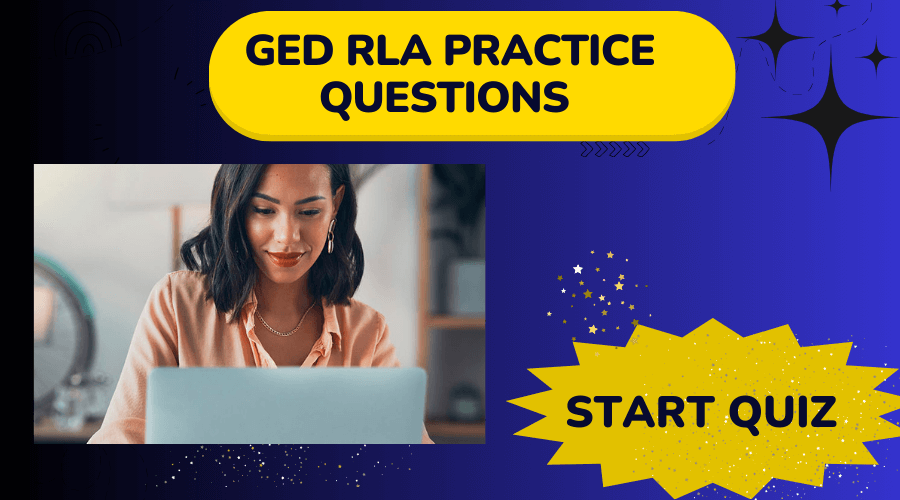As you progress towards earning your GED® credential, you will realize that GED® practice tests are essential. They effectively simulate the actual test environment, familiarizing you with the types of questions you’ll encounter. Please note that our practice tests are not affiliated with or authorized by the official GED Testing Service LLC.
Moreover, practicing with these tests can significantly reduce test-day anxiety by providing a preview of what to expect. Preparing for the GED Language Arts exam should not feel overwhelming because we are here to support you at every stage. Understanding the structure of the federal government is also crucial as it relates to educational content and assessments.
As the most popular GED preparation program, Prepsaret serves as your comprehensive resource hub. Our GED Language Arts practice test is geared to assist you in successfully passing your high school equivalency GED exam.
Our course provides students with thorough answer explanations for the practice questions, which deepen their comprehension of the material.
Overview of the GED Language Arts Test
The GED Language Arts test is a crucial component of the GED exam, designed to assess a test-taker’s reading, writing, and language skills. The test is divided into three sections, each with a unique format and focus. The first section tests reading comprehension, writing, and language content, while the second section is an extended response, or essay component, that requires test-takers to analyze arguments presented in two sample texts.
The third section tests reading, writing, and language skills, with a focus on identifying the main idea, supporting ideas, and defining words in context. This comprehensive approach ensures that test-takers are well-rounded in their understanding and application of language arts.
What to Expect on the Test
On the GED Language Arts test, test-takers can expect to encounter a variety of question types, including multiple-choice, fill-in-the-blank, and drop-down questions. The test also includes an extended response section, where test-takers must write a clear and well-supported essay in response to a prompt.
The test is designed to assess a test-taker’s ability to read closely, analyze complex texts, and express their thoughts and ideas in writing. By familiarizing yourself with these question types and practicing your reading and writing skills, you can approach the test with confidence and clarity.
Importance of GED Language Arts Practice Tests
- Understanding Test Format and Question Types: The RLA test includes multiple-choice, drag-and-drop, and drop-down questions, as well as an extended response essay. Practice tests help you familiarize yourself with these different question types and formats
- Enhancing Reading Comprehension: Practice tests provide opportunities to read and analyze passages, improving your ability to identify main ideas, themes, and supporting details. This skill is crucial for the reading comprehension section of the test
- Boosting Grammar and Language Skills: The RLA test also assesses grammar and language skills. Practice tests help you review and practice identifying correct sentence structures, verb tenses, and other linguistic elements
- Essay Writing Practice: The extended response essay section requires you to write a clear and well-supported essay. Practice tests help you develop your essay writing skills, including planning, organizing, and revising your work
- Time Management and Efficiency: The test has a time limit of 150 minutes, including a ten-minute break. Practice tests help you manage your time effectively, ensuring you complete all sections within the allotted time
- Identifying Weaknesses and Improving Strengths: Detailed scoring results from practice tests help you identify areas where you need improvement. This targeted practice helps you strengthen your weaknesses and build on your strengths
- Building Confidence: Regular practice with practice tests helps build confidence in your abilities. As you become more familiar with the test format and question types, you will feel more prepared and less anxious on the actual test day.
Topics Covered on the GED Language Arts Practice Tests.
The Reasoning Through Language Arts (RLA) test evaluates your ability to comprehend written material and write effectively. It covers a broad range of topics aimed at assessing your grasp of English language and grammar. The reading comprehension portions of the exam include non-fiction passages drawn from various sources such as science, social studies, and business.
Prepsaret supports your preparation for the GED language arts exam by offering practice questions that aid in understanding the tested content.
Related: Outline of the GED Language Arts Exam
Reading Comprehension Practice Questions
The reading comprehension section is the first part of the GED RLA test. Within this section, you will encounter passages or excerpts that you must read thoroughly. Following this, you will need to answer multiple-choice questions based on the text.
Similar to the GED RLA test, our practice questions are specifically designed to assess your understanding of passages and test the various skills required to answer questions on the GED exam.
Identifying Main Ideas and Supporting Details
Just like the GED RLA test, our practice questions require you to understand the main idea of a passage and identify supporting details that help to explain it. This includes recognizing the central theme or argument and the evidence provided to support it.
Analyzing Texts
Our questions prompt you to analyze various types of texts, spanning informational passages and fiction. This includes identifying the author’s purpose, tone, and point of view, as well as comprehending the relationships between different elements within the text.
Understanding Arguments
You’ll practice identifying the structure of arguments, including the claim, evidence, and conclusion. This skill aids in pinpointing the main idea and supporting details within a given passage.
Comparing and Contrasting
Our practice questions develop your ability to compare and contrast different ideas, texts, or themes. This involves identifying similarities and differences between the elements being compared, enhancing your analytical skills.
Cause and Effect
Our questions focus on making you understand how cause-and-effect relationships are presented in texts. This includes identifying both the factors that lead to certain outcomes (causes) and recognizing the outcomes themselves (effects), while also understanding the author’s purpose in illustrating these relationships.
Free GED Language Arts Practice Questions
Question 1
Memorandum
TO: All Staff
FROM: Patricia Hornby, Human Resources Department
DATE: January 6, 2013
RE: Change in Mailing Protocol – Please Read!
After much consideration and discussion, UniPro has decided to change its long-standing protocol for handling outgoing mail.
Effective September 1, our mailroom will no longer accept outgoing mail without a mail authorization slip. You will be required to fill out and clip a mailing slip (paper clips only, NO TAPE OR STAPLES) to each piece of outgoing mail before you submit it to the mailroom or leave it at one of the courier collection points. Multiple items being mailed at the same time by the same employee may be rubber- banded together with a single form covering all items in the batch. Outgoing mail without a mailing slip will either be returned to sender or, if no return address is marked, destroyed.
A sample of the mailing slip will be available next week. As you will see, the form requires each person using our mail service to enter his or her name and Employee ID Number in the blanks provided.
A sample of the mailing slip will be available next week. As you will see, the form requires each person using our mail service to enter his or her name and Employee ID Number in the blanks provided. While we realize this new mailing protocol will add extra steps and possibly frustration to your day, the administration has deemed it a cost-saving measure. At present, we have no way to determine which departments at UniPro are making the fullest use of our mailroom, including charging extra services (same-day or next-day delivery, international delivery, etc.) to the company. Our mailing costs have spiraled upward in recent years. With the new system, we will have a better sense of our postal needs and be able to budget accordingly.
There have also been reports of employees routing their personal mail through our mailroom. Please accept this as a friendly reminder that ONLY UNIPRO MAIL IS TO BE PROCESSED IN OR THROUGH OUR COMPANY MAILROOM. Due to tight budgets we are unable to process your personal mail for you, even if you have provided your own postage. Please send your personal mail through postal depots off-site.
In order to ease the transition, the mailroom staff have indicated that they will be happy to print and photocopy the new mail slips with your name and Employee ID Number preprinted on the blanks. You may also pick up paper clips from the mailroom, which is open from 8:30 a.m. to 4:30 p.m., Monday through Friday. You are also welcome to write your name and Employee ID Number on the attached sample and photocopy the slip yourself.
Eventually we hope to streamline the process by adding a scan code to the mailing slip so that postage costs will automatically be calculated as the mailroom processes the mail. In the meantime, we thank you for your patience and for understanding that our goal is to make UniPro more competitive in the market.
What does the memorandum imply about the current state of UniPro’s budget?
- It is more than sufficient for current needs.
- It is being increased next year.
- It is tight, necessitating cost-cutting measures.
- It is mainly allocated to employee benefits.
Click here to answer and access more questions.
GED Language Arts Test Format
The GED Language Arts test is 150 minutes long, split into three sections. The first section is 35 minutes long and tests reading, writing, and language content. The second section is the extended response, or essay component, and lasts for 45 minutes. The third section is 60 minutes long and tests reading, writing, and language skills.
Test-takers are given a 10-minute break between the second and third sections. Understanding this format can help you manage your time effectively and ensure you are prepared for each part of the test.
Essay Section Practice Questions
After completing the first section of the Literacy (Reasoning through Language Arts-RLA) test on the GED exam, you move on to the “Extended Response” section. Our practice questions mimic the GED test format to thoroughly prepare you for this section of the GED essay.
In our practice questions, your task is to write an essay that involves analyzing various arguments presented in two sample texts. During the Extended Response (writing) portion of the GED test, a topic is introduced through one or more reading passages. Your goal is to conduct a thorough analysis of both the topic and the arguments put forth.
The practice questions are timed to simulate the real GED test experience. You can continue practicing until you feel confident in mastering the necessary skills before taking the test.
Statistics shows that learners who used Prepsaret for test preparation have achieved an impressive 95% pass rate for the GED Reasoning Through Language Arts Test, which includes the essay section.
Register at Prepsaret to get access to Essay practice questions and improve your chances of passing the GED RLA test.
Grammar and Language Practice Tests
Our Grammar and Language Practice Tests are designed to enhance your proficiency in key aspects of English language skills that are tested on the GED RLA exam. By engaging with these tests, you will develop confidence in identifying correct grammar usage, understanding word meanings, and effectively interpreting figurative language.
Specifically, our practice tests support you in:
Grammar: Mastering the fundamentals of English grammar, covering parts of speech, verb tenses, and sentence structure. This includes identifying and correctly using verb tenses, ensuring subject-verb agreement, and recognizing sentence fragments.
Word Choice: Understanding the nuances of word meanings, including positive, negative, and neutral connotations. This involves recognizing how word selection impacts the tone and interpretation of a text.
Figurative Language: Identifying and comprehending various types of figurative language, such as similes, metaphors, and personification. This includes analyzing how these devices contribute to the overall meaning and mood of a passage.
Access More Practice Questions
How to Use Practice Tests Effectively
- Schedule Regular Practice: Set aside dedicated time to practice regularly, ensuring consistent progress and improvement.
- Review and Analyze Results: Carefully review your performance on each practice test, focusing on areas where you need improvement.
- Customize Your Practice: Use practice tests that align with your specific needs and weaknesses, such as focusing on grammar or essay writing.
- Combine with Other Study Methods: Supplement practice tests with other study methods, such as taking GED classes, using online resources, or working with a tutor.
Where Can I Find Additional GED RLA Study Materials
By enrolling in Prepsaret’s online GED prep program, you gain access to additional resources for RLA. In addition to practice tests, Prepsaret offers comprehensive lessons that cover all the topics covered in the GED RLA test.
Each lesson is followed by quick questions that assess your understanding of the concepts taught. The lessons are structured to be clear and concise, aimed at providing extensive support to deepen your understanding of the RLA material.
Furthermore, our online GED Language Arts course features:
- Comprehensive lessons encompassing all key GED Language Arts topics.
- Over 1,250 practice questions for GED Language Arts practice.
Effective Strategies for Passing the GED Language Arts Test
- Skimming: Quickly scan through passages to grasp the general content to get a general idea of the topic and the kind of questions that might be asked. This helps you anticipate the types of questions and focus your reading accordingly.
- Question First, Answer Later: Read the questions before reading the passage. Knowing what you need to find in the passage helps guide your reading and ensures you don’t miss important details.
- Consider the Context: Answers may be found not in specific lines but within the broader context of the passage. Look for clues throughout the surrounding text.
- Use Elimination Method: Eliminate answer choices you know to be incorrect, which can increase your chances of choosing the correct answer.
- Time Management: Manage your time effectively during the test. Read the questions first, and then allocate time for each passage based on the number of questions and your reading speed.
Time Saving Tip!!
If you’re running low on time, use the “seek and destroy” method, where you read a question and then skim the passage until you find the answer. This can be effective but may not work for all questions.
Read more: Why Passing the Ged Is Important
FAQS
Is the Language Arts GED Test Hard?
The Language Arts GED test is not overly difficult, but it does require strong reading comprehension and writing skills. The test is lengthy at 150 minutes, which can be challenging for some.
However, with proper preparation, such as developing a regular reading habit, practicing writing, and managing time effectively, most test-takers can pass the Language Arts GED test.
What Is the Most Difficult GED Test?
The most difficult GED test is often debated among test-takers. However, based on general consensus and data, the Mathematical Reasoning test is typically considered the most challenging.
This is because it requires strong algebraic and geometric skills, which can be daunting for some students. Additionally, the test format and time constraints can add to the difficulty level. However, with the right resources, such as Prepsaret's comprehensive practice tests and study materials, you can make the test more manageable.
What Kind of Language Arts Is on the GED Test?
The GED Language Arts test assesses your comprehension and command of the English language. It includes multiple-choice questions on fiction, poetry, drama, and nonfiction texts.
The test evaluates your ability to understand, analyze, and communicate effectively in English. Additionally, it includes an extended response essay section where you must write a coherent and compelling essay based on given prompts.
What Topics Are Covered in the Prepsaret GED Language Arts Prep Course?
The Prepsaret GED Language Arts Prep Course covers a comprehensive range of topics, including grammar, sentence structure, reading comprehension, and writing.
It includes lessons on identifying main ideas, supporting details, and the author's purpose, as well as practice writing essays and answering multiple-choice questions.
The course also provides detailed explanations and practice tests to help you master the skills needed to pass the GED test.
Does Prepsaret Offer GED Language Arts Practice Test?
Yes, Prepsaret offers a comprehensive resource for GED Language Arts test preparation, providing numerous practice test questions with detailed explanations to help you thoroughly prepare for the exam.
These practice tests are designed to be accessible from your mobile phone, making it easy to study on-the-go. These free tests are a great way to gauge your knowledge and identify areas where you need to focus your studies.
Additionally, most of these tests mimic the actual GED social studies test, ensuring that you are well-prepared for the exam. With Prepsaret's practice tests, you can confidently prepare for the GED Language Arts test and achieve your goals.
Is Prepsaret GED Language Arts Prep Course Suitable for All Levels of Learners?
Prepsaret GED Language Arts Prep Course is designed to be accessible to learners of all levels. It includes a self-assessment tool to identify strengths and weaknesses, and personalized lessons and practice questions to help improve skills.
The course is flexible and can be completed at one's own pace, making it suitable for learners with varying levels of proficiency.




